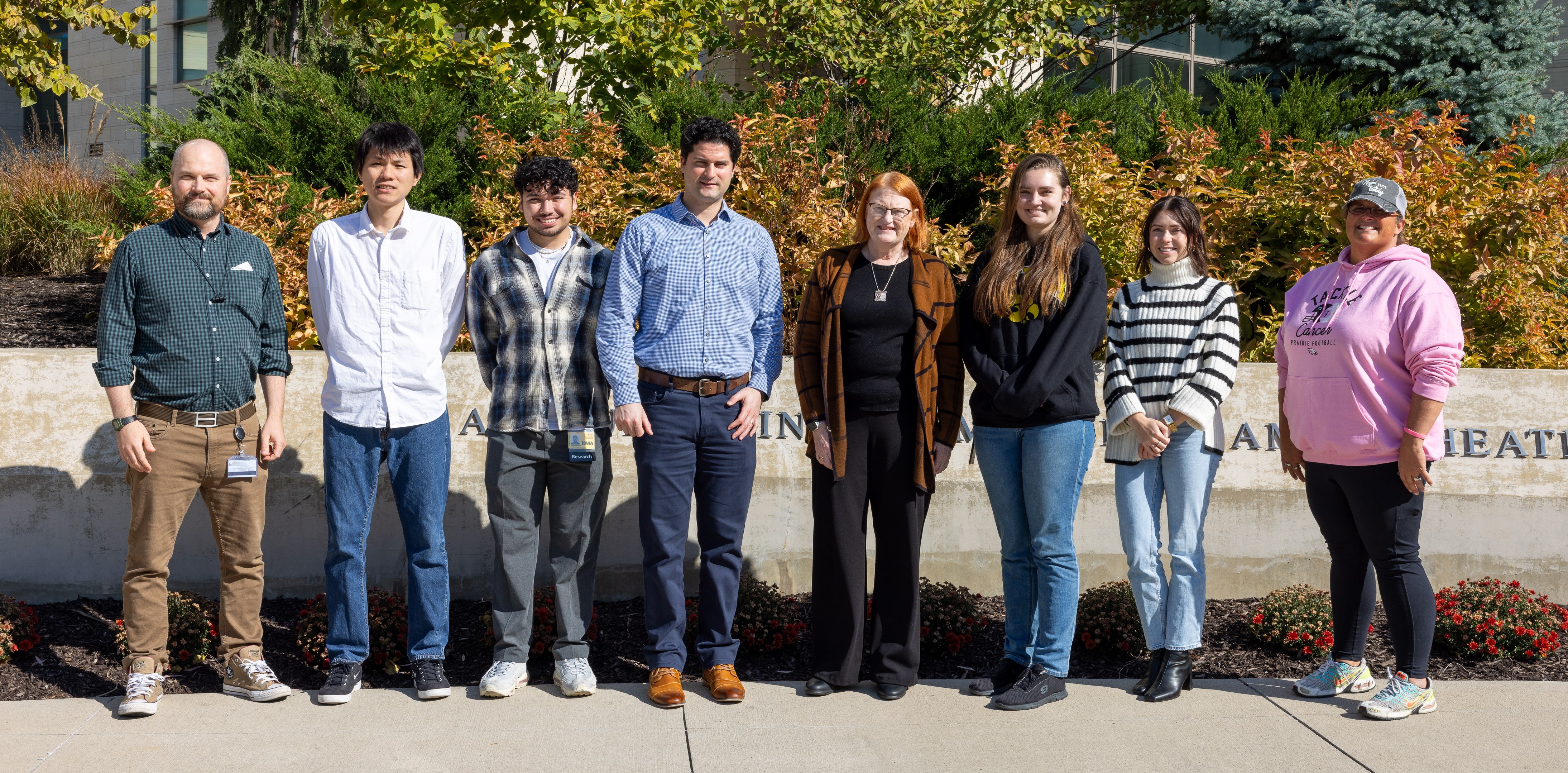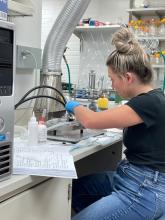
Director
Kathleen A. Sluka, PT, PhD, FAPTA
Location
3148 Medical Laboratories
Phone: (319) 384-4442
Research Interests
Dr. Sluka's translational research laboratory focuses on a translational research musculoskeletal pain mechanisms and non-pharmacological treatments for chronic pain. These studies involve the use of animal models of muscle pain developed and characterized in Dr. Sluka's laboratory, as well as projects in human subjects. Current research projects involve 1) animal models investigating mechanisms involved in the transition to chronic pain, mechanisms of activity-induced pain, mechanisms of activity-induced analgesia, sex-differences in chronic pain; 2) biomarkers discovery research in several human pain conditions including post-surgical pain, fibromyalgia, ME/chronic fatigue, long-COVID; and 3) implementation of non-pharmacological therapies into clinical practice. Our overall goals are to improve the management of pain for people with a variety of musculoskeletal pain conditions by discovering the underlying mechanisms that lead to the development of chronic pain, discovering new therapies for pain management, and improving the use of currently available treatment for pain.
Cells of Life
Dr. Sluka has displayed her artwork "Cells of Life" through Project Art at the University of Iowa Hospitals & Clinics (UIHC) and in the sky gallery of the Pappajohn Biomedical Discovery Building and the Medical Education and Research Facility. You can view her artwork at kathleenslukaart.com.
Pain Research Forum - Webinar by Dr. Sluka
Dr. Sluka presented a webinar for the Pain Research Forum on November 18, 2016 entitled "Exercise-induced pain and analgesia: role of the innate immune system". She discusses her latest data showing differences in the immune system between sedentary and physically active animals. Click to view the video of the presentation and the discussion that followed. The Pain Research Forum is an interactive web community dedicated to finding treatments for untreatable pain conditions and provides a resource for researchers interested in studying pain.
Current Projects
Neurobiology of muscle pain.
Goal: Examine the underlying mechanisms for how exercise can exacerbate pain
These studies involve examining the mechanisms that contribute to exercise induced pain. In people with chronic pain, acute physical activity and exercise can exacerbate their pain. Our laboratory has developed models of chronic muscle pain that involve repeated muscle insults or combining fatiguing stimuli with low-dose muscle insult to produce long-lasting widespread muscle pain. We are currently examining 1) the sex differences in the development of widespread pain, 2) the role of the immune system in the development of exercise-induced pain, and 3) sites, neurotransmitters, and receptors in the brainstem.
Funded by NIH AR073187
Recent References:
- Lesnak JB, Inoue S, Lima L, Rasmussen L, Sluka KA. Testosterone protects against the development of widespread muscle pain in mice. Pain. 2020;161(12):2898-2908.
- Sluka KA, Frey-Law L, Hoeger Bement M. Exercise-induced pain and analgesia? Underlying mechanisms and clinical translation. Pain. 2018 Sep;159 Suppl 1:S91-S97.
- Merriwether EN, Agalave NM, Daily DL, Rakel, BA, Kolker SJ, Lenert ME, Spagnola WH, Lu Y, Geasland KM, Allen LH, Burton MD, Sluka KA. IL-5 mediates monocyte phenotype and pain outcomes in fibromyalgia. Pain. 2020;162(5):1468-1482.
- Chimenti RL, Hall MM, Dilger CP, Merriwether EN, Wilken JM, Sluka KA. Local anaesthetic injection resolves movement pain, motor dysfunction, and pain catastrophizing in individuals with chronic Achilles tendinopathy: a nonrandomized clinical trial. J Orthop Sports Phys Ther. 2020;50(6):334-343.
- Oliveira-Fusaro MC, Gregory NS, Kolker SJ, Rasmussen L, Allen LH, Sluka KA. P2X4 receptors on muscle macrophages are required for development of hyperalgesia in an animal model of activity-induced muscle pain. Mol Neurobiol. 2020;57(4):1917-1929.

Exercise-induced analgesia.
Goal: Examine the underlying mechanisms for how exercise can prevent and reduce pain
Regular physical activity and exercise is an effective treatment for existing chronic pain and can prevent the development of chronic pain. Our laboratory is examining the underlying mechanisms for how regular physical activity and resistance exercise can prevent the development of pain and reduce existing chronic pain using animal models. We exercise animals with running wheels to simulate regular physical activity, on a treadmill to simulate a regular exercise program, or with resistance training program and compare these to sedentary animals. We are currently examining: 1) the central mechanisms underlying this analgesia: sites, neurotransmitters, and receptors in the brainstem, 2) immune mechanisms underlying this analgesia, and 3) role of sex hormones in the analgesia.
Funded by NIH AR073187
Recent References:
- Lesnak JB, Sluka KA. Mechanism of exercise-induced analgesia: what we can learn from physically active animals. Pain Rep. 2020;5(5):3850.
- Sluka KA, Danielson J, Rasmussen L, Kolker SJ. Regular physical activity reduces the percentage of spinally projecting neurons that express mu-opiod receptors from the rostral ventromedial medulla in mice. Pain Rep. 2020;2;5(6):3857.
- Bobinski F, Teixeira JM, Sluka KA, Santos ARS. Interleukin-4 mediates the analgesia produced by low-intensity exercise in mice with neuropathic pain. Pain. 2018;159(3):437-450.
Effectiveness of transcutaneous electrical nerve stimulation.
Goal: Test the effectiveness of TENS for pain during activity in people with fibromyalgia
Transcutaneous electrical nerve stimulation (TENS) is a non-pharmacological treatment for chronic pain commonly used by physical therapists. Our laboratory has discovered the underlying mechanisms for how TENS works using animal models and translating these findings into human subjects. We have discovered that TENS reduces central excitability and increases central inhibition in an opioid-dependent manner. We have subsequently shown that TENS is more effective for evoked pain such as hyperalgesia and pain during activity, when compared to resting pain. We recently completed a two-site clinical trial testing the effects of home usage of TENS during physical activity in people with fibromyalgia on a variety of outcomes measures including pain during movement, fatigue, psychosocial variables, function, and quality of life. We are now performing a progmatic clinical trial determining if application of TENS to standard physical therapy care enhances reduction in movement-evoked pain and promotes adherence to physical therapy exercises. Visit www.fmtips.org for more details on the study.
Funded by NIH UH3/UG3 AR076387
Recent References:
- Vance CG, Zimmerman MB, Dailey DL, Rakel BA, Geasland KM, Chimenti RL, Williams JM, Golchha NM, Crofford LJ, Sluka KA. Reduction in movement-evoked pain and fatigue during initial 30-minute TENS treatment predicts TENS responders in women with fibromyalgia. Pain. 2020;62(6):1545-1555.
- Dailey DL, Vance GCT, Rakel BA, Zimmerman MB, Embree J, Merriwether EN, Geasland KM, Chimenti R, Williams JM, Golchha M, Crofford LJ, Sluka KA. Transcutaneous electrical nerve stimulation reduces movement-evoked pain and fatigue: a randomized, controlled trial. Arthritis Rheumatol. 2020;72(5):824-836.
- Govil M, Mukhopadhyay N, Holwerda T, Sluka K, Rakel B, Schutte DL. Effects of genotype on TENS effectiveness in controlling knee pain in persons with mild to moderate osteoarthritis. Eur J Pain. 2020;24(2):398-412.
- Gewandter JS, Chaudari J, Ibegbu C, Kitt R, Serventi J, Burke J, Culakova E, Kolb N, Sluka KA, Tejani MA, Mohile NA. Wireless transcutaneous electrical nerve stimulation device for chemotherapy-induced peripheral neuropathy: an open-label feasibility study. Support Care Cancer. 2019;27(5):1765-1774.
Biomarkers of acute and chronic pain.
Biomarkers have become increasingly important in improving diagnosis and prevention of disease, developing novel strategies for treatment of disease, and examining outcomes of effective treatments. 20-50% of individuals with acute pain after surgery will develop chronic pain 6 months later. The Acute to Chronic Pain Signatures Program is a large consortium that aims to determine biomarkers that predict which individuals are likely to transition from an acute postsurgical pain event to chronic pain, and which individuals are likely to be resilient to developing chronic pain. The study is longitudinal of resilence and susceptibility to chronic pain after surgery in 3,600 patients, incorporating a comprehensive set of psychosocial, neuroimaging, genomics, proteomics, lipidomics, and metabolomics biomarkers prognostic of the transition to chronic pain. We will combine a biomarker validation approach testing extant leading candidates with a discovery science approach aimed at identifying new mechanistic causes of pain and therapeutic targets. Our group serves as the Clinical Coordinating Center for the landmark study. Visit www.a2cps.org for more details on the A2CPS study.
Fibromyalgia is a condition that is diagnosed based on symptomology. It is difficult to diagnose an often goes undiagnosed for years delaying effective treatment. Our group recently discovered potential biomarkers in the citric acid cycle in individuals with fibromyalgia that are uniquely different from healthy controls. We are collaborating with the University of Michigan to validate the specificity and sensitivity of these metabolic biomarkers in a large cohort of individuals with chronic pain. We have recently translated these findings and started testing the role of these biomarkers in animal models of pain.
Funded by NIH U24 NS112873 and AR077418